
Heading to El Yunque National Forest in Puerto Rico? You’re in for a treat! Why? Simply put: Puerto Rico lo hace mejor; Puerto Rico does it better!
The tourism motto of Puerto Rico is a unique case of truth in advertising. This Caribbean island and territory of the United States has an abundance of natural wonders, vibrant culture, and terrific cities with plenty to do and see.
And I’m here to tell you about an extraordinary place on the island that is close to my heart. I’m talking about the eye-opening, jaw-dropping El Yunque National Forest!
In this article I’ll cover:
- general information about El Yunque
- entrance and admission info
- which trails are open
- how to get to El Yunque
- my recommendations for a one-day self-guided El Yunque itinerary
- an overview of the best things to do in El Yunque, including helpful information about waterfalls and trails
Let’s get to it!
Where is El Yunque National Forest?

El Yunque is often described as the only rainforest in the United States. And that is partially true (you’ll find the other one in this post!). In actuality, El Yunque is the only tropical rainforest in the United States national forest system!
Located in the northeast of Puerto Rico, this tropical rainforest sits on the slopes of the Sierra de Luquillo, or Luquillo Mountain Range in English.
It covers close to 29,000 acres of land. Though relatively small in size, it is home to nearly 240 species of trees, of which 23 are found nowhere else in the world!
El Yunque’s footprint stretches into eight neighboring municipal areas and can be reached from the nearby coast within 15 minutes. Cities and towns near El Yunque include the eponymous Luquillo, Fajardo, Ceiba, Naguabo, and Loiza. And if you’re staying in Old San Juan or San Juan, it’s an easy drive away, making it the perfect day trip.
What’s open in El Yunque National Forest?

Unfortunately due to the long-lasting effects of Hurricane Maria and Tropical Storm Isaiah, the Forest Service has closed certain trails and falls to the public.
The park is rebuilding some of the other hiking trails in El Yunque as well, so as a rule of thumb, check here for current Alerts & Notices.
This Visitors Access Report is also a helpful tool, though I’m not sure how often it is updated!
Here is a table of all of El Yunque trails and their status as of 2023. You can click on each individual trail to check its status on the US Forest Service Website.
| Trail Name | Status | Length | Difficulty | Road |
|---|---|---|---|---|
| El Toro Wilderness Trail | Open | 2.3 miles | Difficult | Carr. 186 |
| Baño de Oro Trail | Open | 0.3 miles | Easy | Carr. 191 N |
| Big Tree Trail | Closed | 0.9 miles | Moderate | Carr. 191 N |
| Caimitillo Trail | Open | 0.4 miles | Easy | Carr. 191 N |
| El Portal Trail | Open | 0.3 miles | Easy | Carr. 191 N |
| El Yunque Rock | Open | 0.1 miles | Moderate | Carr. 191 N |
| El Yunque (Peak) Trail | Open | 2.6 miles | Difficult | Carr. 191 N |
| Juan Diego | Open | 0.12 miles | Easy | Carr. 191 N |
| La Coca Trail | Open | 1.8 miles | Very difficult | Carr. 191 N |
| La Mina Trail | Closed | 0.7 miles | Difficult | Carr. 191 N |
| Los Picachos | Open | 0.2 miles | Moderate | Carr. 191 N |
| Mt. Britton Spur / FS 10 | Temporarily closed | 0.3 miles | Difficult | Carr. 191 N |
| Mt. Britton Trail and Tower | Open | 0.8 miles | Difficult | Carr. 191 N |
| Tradewinds Trail | Temporarily closed | 4.6 miles | Very difficult | Carr. 191 N |
| Río Sabana Trail | Temporarily closed | 2.2 miles | Difficult | Carr. 191 S |
| Angelito Trail | Open | 0.2 miles | Easy | Carr. 988 |
* Currently, it says that El Yunque Peak Trail is open to Los Picachos, but is still closed between Los Picachos spur trail and El Yunque Peak.
Entrance Cost, Reservations, & Permits
Here is some logistical information that you’ll need to know for entering El Yunque National Forest.
Does El Yunque still require reservations?
No, from August 2023, El Yunque National Forest no longer requires reservations. However, it’s a good idea to get there early, as it is first-come, first-served!
Due to park regulations to avoid crowding, only 200 cars will be let in each morning. Once the 200-car capacity has been reached, the gate will be closed, and will reopen for the entry of 20 more vehicles only when 20 have left.
El Yunque Hours
El Yunque is open from 8 am to 5 pm.
Can you hike El Yunque without a tour?
Yes! We rented a car from San Juan and explored El Yunque on our own. Many trails and waterfalls are easily accessible without a guide. In just a bit, I’ll go over my recommendations for a self-guided El Yunque itinerary.
And PLEASE NOTE that the forest entrance gate at La Coca falls closes at 5:00 pm… so keep track of the time so you don’t get stuck in El Yunque!
Is El Yunque Rainforest free? How much does it cost to enter El Yunque?
Yes, it’s free! There used to be a $2 reservation fee, but there is now no charge.
Getting to El Yunque National Forest

The best ways to explore El Yunque are through a tour or on your own by car. Rideshare options, such as Uber, are not available within the forest.
Booking A Tour
As I mentioned earlier, you can pretty easily go to El Yunque without a tour.
While a drive to El Yunque is necessary, booking a tour is not. This option is a personal preference and comes at an elevated cost. The reality is that, with a reliable GPS and game plan, an El Yunque self-guided tour is possible.
However, there are instances where you might want to book a tour when visiting El Yunque.
Suppose you are uncomfortable driving along Puerto Rico’s notoriously potholed highways or have a fear of driving along cliffsides in the Luquillo Mountains. (The normal areas on PR-191 through El Yunque are not cliffside, though some less common areas can be!) In that case, you may want to book a tour for transportation alone.
An El Yunque guide will remove any level of stress, no matter how minimal, from the planning process so that you can focus on the natural marvels and immense biodiversity that can be found in the national forest. This includes building an El Yunque itinerary of all of the main spots to visit, as well as attractions only locals know about.
Having said that, the best option for independent travelers who want to go at their own pace is to rent a car and make their own way to El Yunque.
If you do choose to book a tour, here are some options you’ll find on Viator with great reviews:
- This day tour picks you up from your hotel in San Juan, Carolina, Rio Grande, or Luquillo
- This hiking tour focuses on going off the beaten path
- Combine a trip to El Yunque with a bioluminescent bay on this tour (I’d only do this one if you’re visiting not during a full or semi-full moon.)
Exploring By Car

Rental cars are readily available in Puerto Rico’s capital, San Juan. Chances are high that you will arrive at Luiz Munoz Airport in Carolina. The airport is just east of San Juan and you can book your car at the airport.
Alternatively, for a lower price, rent your car in the city proper without paying the inflated airport cost.
We did a day rental from the Enterprise in San Juan and it was ridiculously easy! When we returned the car, we just left the keys in a drop box and walked back to our hotel!
The drive from San Juan usually takes you about 45 minutes, but plan for the trip to take longer. Traffic can come out of nowhere along PR-3, the main highway that you will be taking. Switch on Google Maps and pay special attention to the turn into El Yunque when you reach Rio Grande. The exit is in an unassuming residential area and very easy to miss!
The trip from Ponce in the south of the island will take you twice as long. You’ll travel along PR-52 until you reach Rio Grande and enter at the same location.
If you plan to hike your way through the rainforest and up toward one of the peaks, you can leave your car near the El Portal Visitor Center.
However, the most comfortable option is to drive up as far as the road will take you. Then you’ll park your car along the side of the road or at one of the small lots near the forest’s popular landmarks.
** Once again, note that rideshare services do not work in El Yunque, so Uber is not an option. **
Heading to San Juan? Check out this post on my favorite things to do in the area!
A One-Day El Yunque National Forest Itinerary

El Yunque is a tropical rainforest which means rain can fall at any point during your visit. (It definitely did when we visited!)
Hey – it’s not called El Yunque rainforest for nothing! The rainforest sees approximately 200 inches of rain annually! This rain can make hiking (or driving) a bit of a challenge.
Whether you choose to hike or drive to El Yunque’s top spots, bring a raincoat or a change of dry clothes and a towel if you can. We definitely got poured on, but it just added to the rainforest fun!
El Yunque’s soil has a high concentration of clay and that makes for some muddy and slippery climbing every once in a while! The soil appears in a variety of colors from yellow to red. It creates a beautiful tapestry below the lush plants that stretch into the sky.
If you’re doing a day trip to El Yunque National Forest, I recommend entering on the road PR-191 (which you may also see as Carr. 191N). PR-191 is the main road that takes you through El Yunque, and along the way, you’ll find various waterfalls, towers, and trails.
Here are the stops you should make on a self-guided tour through El Yunque:
- La Coca Falls– spend about 30 minutes here
- Juan Diego Falls– spend about 45 minutes to 1 hour here
- Hike to El Yunque Peak– 4 hours plus 30 minutes at the top
- Hike Mt. Britton Tower– 1.5 hours plus 30 minutes at the top
- La Mina Falls (if it has opened by the time you read this)- spend about 1.5 hours hiking plus 1 hour enjoying the falls
- Yokahu Tower– spend about 30 minutes here
If you add up the maximum time I allocated at each spot, you get 11 hours. And that doesn’t include drive time or stopping for a picnic lunch! Since El Yunque is open from 8 am to 5 pm, that’s only 9 hours of open time. As a result, you’ll want to pick and choose wisely as you plan your itinerary.
So, let’s look at these spots in more detail!
La Coca Falls

La Coca Falls is the easiest large waterfall to access in El Yunque. It is right on PR-191, across from a scenic lookout. As you drive into the park, you’ll find it on your right-hand side just a bit after the entrance gate.
The waterfall drops 85 feet, more than double the distance of La Mina (more about La Mina in a sec)! Most of it cascades across the face of a massive rock formation.
Most people just walk up to the edge of the road to get the photo above. But my recommendation is to actually climb up the rocks on the left side of the falls.
The higher elevations allow for some really awesome picture-taking opportunities both above and below.

You’ll get to see the falls close up, and the photo ops here are way better!
Across from La Coca is Las Cabezas Observation Point. There, you can see the rainforest and the mountain range spread out as far as the eye can see.
Juan Diego Falls

Next, you’ll drive a bit further down PR-191 until you reach the parking lot for Juan Diego Falls.
This is by far my favorite waterfall in El Yunque!
A quick hike (probably about five minutes or so from the parking lot) and you’ll arrive at the main part of Juan Diego Falls.
Here’s a little-known fact: there are two sections of Juan Diego Falls.
You’ll arrive at the lower section of the falls, and it’s honestly not that impressive, especially compared to the other falls in El Yunque. It’s also where you’ll find a bunch of people.

But if you look off to the right when you arrive, you’ll see a small dirt path in the forest.
The path brings you up a steep, muddy, slippery, rocky hill, so I recommend only traversing it if you’re in good health! And I advise against flip-flops since it’s so slippery, though I did see a girl do it in flip-flops.
When you reach the fork in the path, go left. A few minutes later, you’ll reach a clearing where you’ll see this way more epic waterfall!

The upper falls are a bit of a hidden gem- chances are there will only be a handful of people there!
We actually had it all to ourselves for a good while! (Hence, why I’m so happy in the photo above!)
Mt. Britton Tower
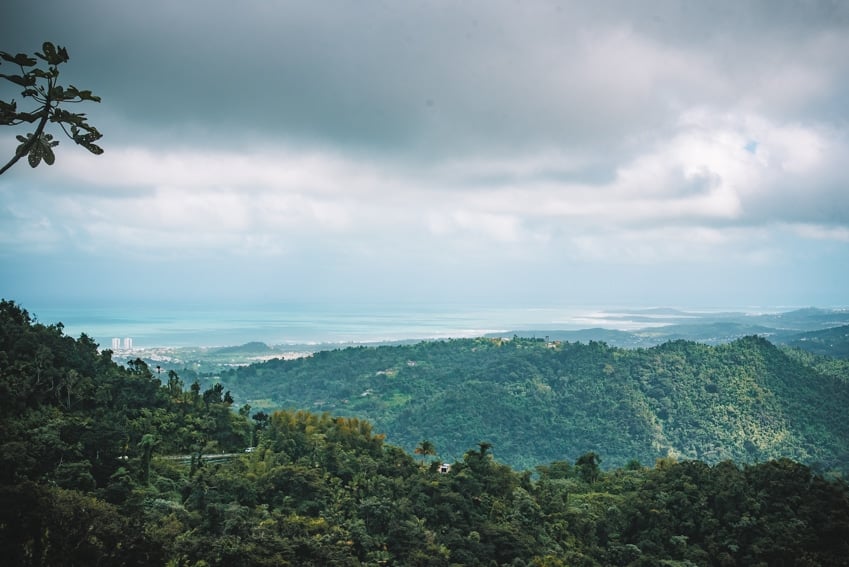
Next, as you continue down PR-191, you’ll encounter the hike to Mt. Britton Tower (aka Torre Britton). It’s one of two observation towers accessible in this part of El Yunque.
And get ready for some sore limbs!
In less than a mile, you’ll climb 594 feet! The hike has an elevation of 2,493 feet, and as such, offers some spectacular views.
The 0.8-mile hike takes about 45 minutes one way, so be sure to have roughly 2 hours to spare.
El Yunque Peak Trail
Alternately, consider hiking to El Yunque Peak if you have the time and are an avid hiker. This 2.6-mile trail is considered a moderately challenging route and it can take about 4 hours to complete. It’s also a very popular hiking area, so expect to encounter people with their kids – and even those with dogs on leashes! – when you visit.
Just keep in mind that El Yunque closes at 5 PM, so if you don’t have at least 4 or 5 hours to spare, you’ll want to skip this trail or come back for it another day.
Picnic at Caimitillo Picnic Area
Before or after your hike, stop for lunch at the Caimitillo Picnic Area. You’ll want to pack food for your day in El Yunque since there are no restaurants in this national forest. And, of course, you can choose to eat along your hike, too. Just be sure to leave no trash behind!
La Mina Falls
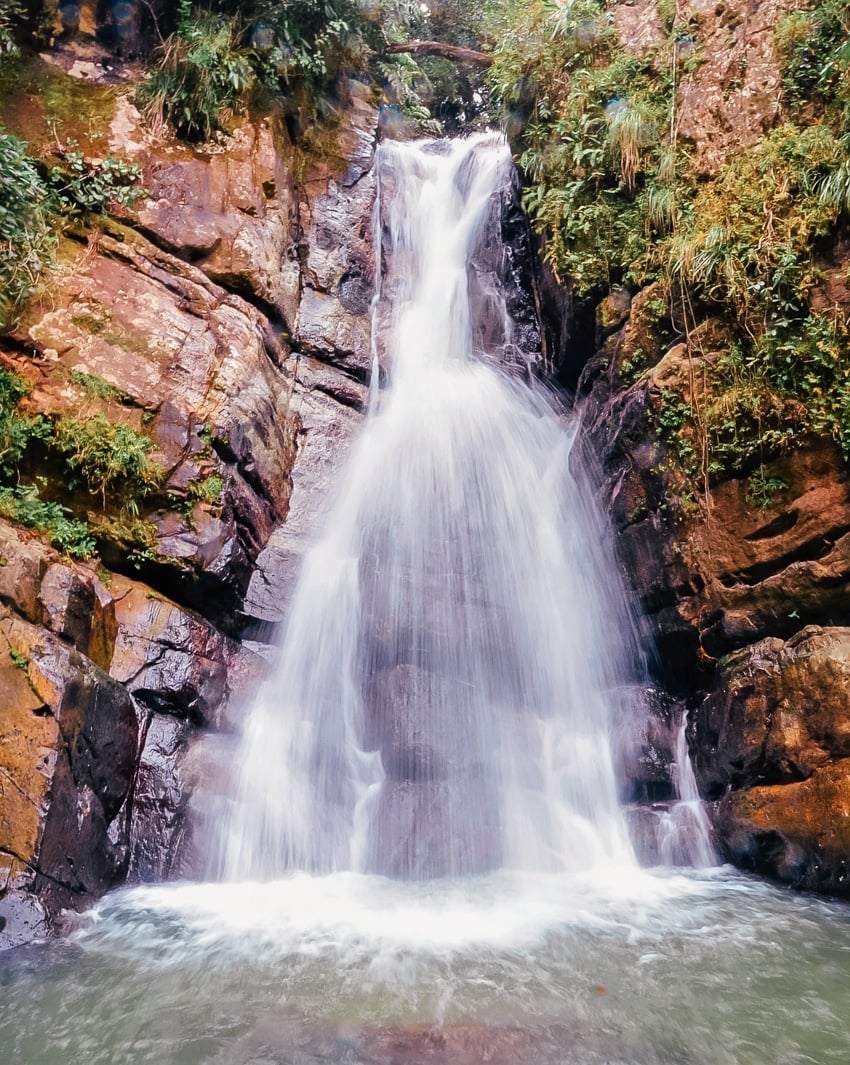
La Mina falls trail is currently closed, with an expected reopening date sometime in 2024. Check here to see if it’s open yet!
By now, you’ve driven to the end of PR-191, and it’s time to hit the spots that will be on your right on your way back down the road.
If it’s open, La Mina is an excellent stop!
La Mina Falls is a beautiful gem of a waterfall at the end of a hike along the Rio de la Mina.
Follow PR-191 until you reach the parking lot of the Palo Colorado Information Center where you will find the trailhead for La Mina Trail.
When open, the trail is heavily trafficked so be prepared to share the narrow dirt paths and stone steps with other visitors walking to and from the falls. The trail is 1.5 miles roundtrip and has multiple areas with steep steps making it a strenuous trip for some.
The total elevation of your hike is 1,640 to 2,132 feet and the journey will take you roughly an hour and twenty minutes to and from the falls. There are picnic facilities along the trail if you planned ahead and packed a lunch.
However, the area near the waterfall itself is not for picnicking and there are no trash cans around, so make sure to take everything you bring with you back to the car or the visitor center.
When it’s open, La Mina is a popular waterfall! The water from Rio de la Mina drops 35 feet into a pool that is open for swimming. The rocks can be a bit slippery, so mind your step when getting into the water. Stack your shoes and belongings away from the water and take a dip!
Yokahu Tower

Further down the PR-191 stands the 69-foot Yokahu Tower. It’s right off the side of the road, which means no hiking is needed.
However, to get to the top, you’ll need to climb a tall spiral staircase with windows (that you can see in the photo above) that show off beautiful views along the way.
The tower was built in the 1960s as part of observation and conservation efforts in the national forest.
You can climb the spiral steps for views of four different types of forests including Colorado, Tabonuco, Palm, and Cloud forests.

On a clear day, you can even see the Virgin Islands!
Be sure to have your camera at the ready because the views are incredible, especially the misty mountains and clouds hanging above the rainforest canopy.
By now, it’s probably close to 4:30 pm, which means it’s time to exit the park before it closes at 5 pm!
And that concludes my recommendations for a one-day itinerary in El Yunque.
However, that isn’t all there is to do! Here are some more of the top things to do in El Yunque National Forest!
Top Things to Do in El Yunque National Forest

I’ve mentioned some of the best stops along PR-191 N, which are:
- La Coca Falls
- Juan Diego Falls
- Hike to El Yunque Peak
- Mt. Britton Tower
- La Mina Falls
- Yokahu Tower
But these spots are by no means all there is to do in El Yunque National Forest! Here are a few more popular hikes you may want to add to your El Yunque itinerary:
Other Hikes From PR-191 N
There are a variety of other hikes in the main section of El Yunque that is accessible by driving on PR-191. Again, check before going to see if the hike you want to do is open!
Baño De Oro Trail
You’ll enjoy visiting this short 0.3-mile trail where you can even spot some old fish hatchery tanks from the 1930s! (Spoiler alert: the trout didn’t want to spawn in the tropical climate, so attempts to breed them here were unsuccessful.) It’s located by the Palo Colorado Information Center where you can also see the Baño Grande Observation Point.
Big Tree Trail
This 0.9-mile trail is called the “Big Tree Trail” because of the large Tabunoco trees found along the trail. But the actual trail itself is paved with asphalt throughout.
Unfortunately, this trail is closed for now.
La Coca Trail
This is apparently one of the lesser-known trails in El Yunque. And that’s probably because it’s a bit more challenging than what you can expect out of regular trails! This is a downhill trail, so better be prepared if you’re adamant to undertake it – especially as you need to climb back up on your way out! It’s steep, muddy, and calls for several stream crossings. This 1.8-mile trail takes about 1.5 hours one way.
Hike From PR-988
Located 2.2 miles from the intersection of PR-988 and PR-191 (relatively close to the main entrance to El Yunque) you’ll find the Angelito Trail.
Angelito Trail
This is a short 0.4-mile trail that takes about 20 minutes to hike, making it great for younger children and even school groups to visit. As you go down the trail through the Tabunoco trees, you can really hear the sounds of the river enticing you to go visit Las Damas Pool and the other gorgeous swimming spots there.
Hike From PR-186
Located in the southwestern section of El Yunque National Forest, this area is pretty remote!
El Toro Peak Trail
This peak is the highest in the Luquillo Mountain Range and is very difficult to reach. The hike will take you roughly three hours one way along the 2.3-mile El Toro Trail.
The trail and peak are located in El Toro Wilderness, a remote area of El Yunque where you won’t find many other people.
It’s actually in a whole different section of the forest- you won’t find it along PR-191. It’s on Road 186, and if you’re driving it, proceed with caution as it has poor road conditions.
And for those who do venture into the wild, the trail to the peak provides ample opportunity to see Puerto Rico’s wildlife.
There are only a handful of animal species that are endemic to Puerto Rico including varieties of frogs, bats, and the Puerto Rican Parrot.
Listen for the sound of the ubiquitous Coquis, a collective term for dozens of small frog species that have become an unofficial symbol of the island.
The elusive Puerto Rican Parrot is another creature that you should keep an eye out for. The tropical bird has been endangered for a while. To make matters worse, damage from Hurricanes Irma and Maria hampered ongoing conservation efforts. Finding a Puerto Rican Parrot is equivalent to finding gold!
Hike From PR-191 South
PR-191 continues in the southern side of El Yunque National Forest, which is where you’ll find this next trail.
Río Sabana Trail
You’re in for a difficult trail on this 2.2-mile trail, which serves as a connection to Tradewinds Trail. Unfortunately, Río Sabana Trail is temporarily closed for now – but check it often to see if that changes! It’s located along PR-191 South in Naguabo and takes you through the wilderness with little-to-no cell phone signal. It takes about 3 hours to complete.
Where to Stay
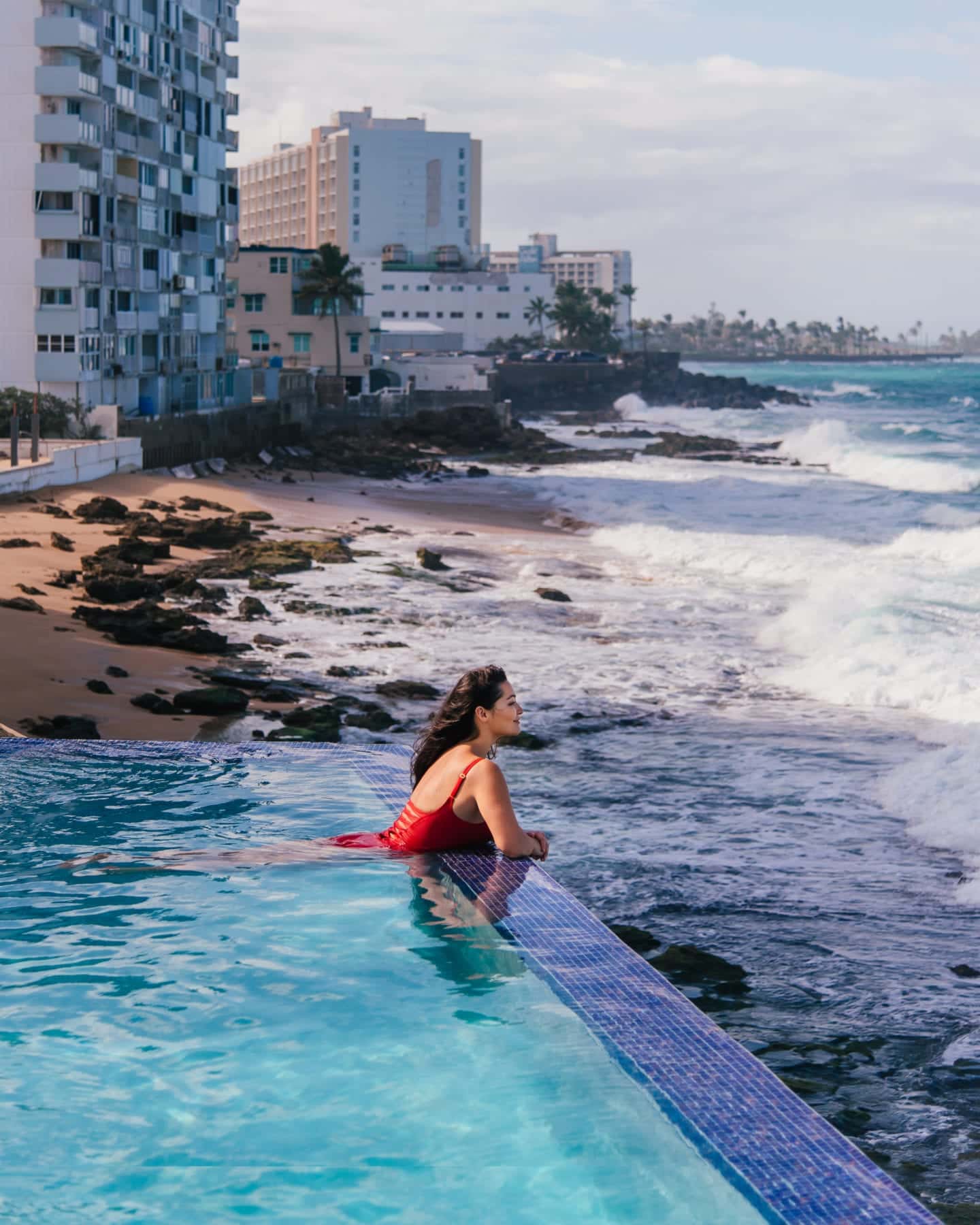
You have plenty of options when it comes to lodging around and in El Yunque.
San Juan
Since the drive from the capital city, San Juan, takes just under an hour, I recommend staying here and making a day trip (or two) to El Yunque.
The city is full of history and is the undisputed capital of culture as well. The nightlife in La Placita is booming, with music and dancing stretching well into the night. You can visit Old San Juan in the daytime where colorfully painted buildings full of cafes and boutique stores line narrow streets.
There are several lodging options in the city, including hotels, resorts, and apartment rentals.
We stayed at the Condado Vanderbilt and loved it! How gorgeous is the view from the pool?
Another great option is to book an apartment along the beach in Condado which is a five-minute drive from the main strip. That way, you get to experience the sea, sand, and city life when you aren’t exploring the tropical rainforest.
Check out my post here on my favorite things to do in San Juan!
Staying in El Yunque
Staying inside the rainforest is an option as well, though you will be further removed from the city. But perhaps that’s the idea!
There are a handful of eco-lodges inside the national forest with limited space available for guests. The Rainforest Inn is one such place, located in a remote area nestled among the forest’s trees.
Twenty minutes drive from the beach in Luquillo and five minutes walking to several trailheads, the inn has access to a private trail that will take you to a personal waterfall that only guests get to see!
History and Culture
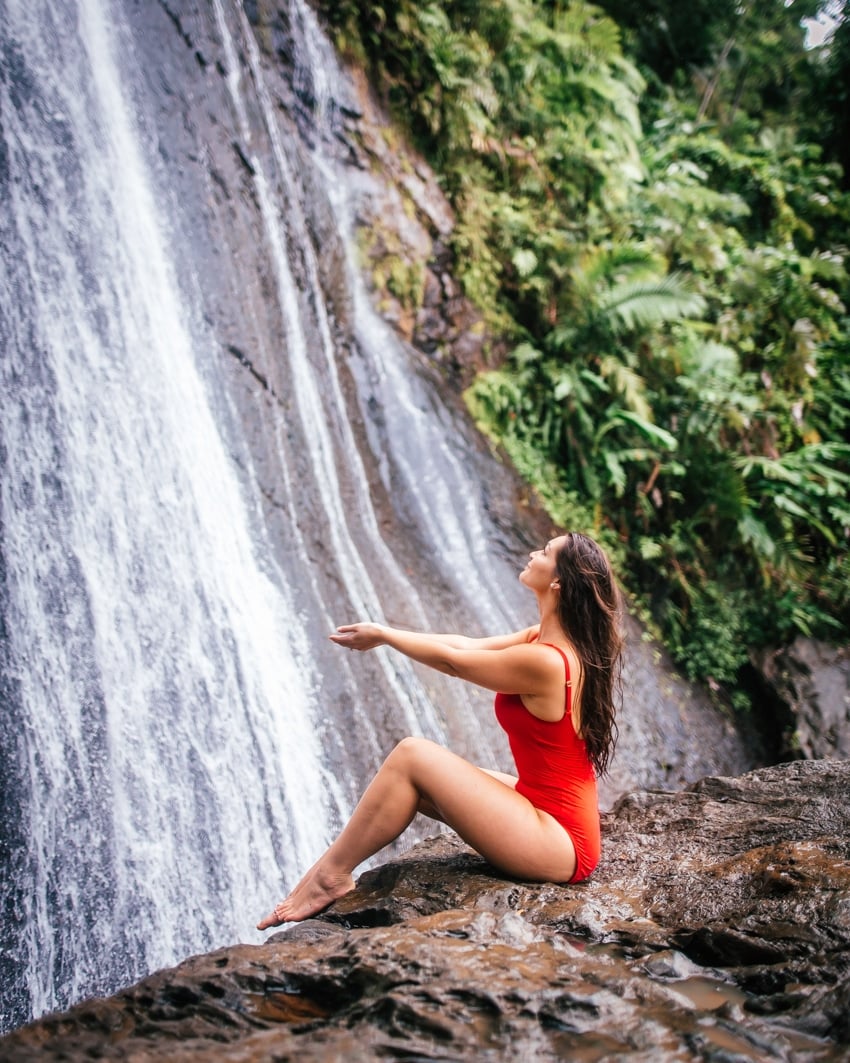
Here are some fast facts about El Yunque to give you some context of the tropical rainforest’s importance to Puerto Rico.
The rainforest was not always known as El Yunque. Though commonly called El Yunque by Puerto Ricans, the rainforest was called the Caribbean National Forest until 2006. President George Bush issued an executive order which officially renamed it to El Yunque National Forest.
El Yunque has a lot of biodiversity packed into a small area. Though the rainforest only occupies 30,000 acres, it has a greater variety of tree species than all of the other national forests combined. That’s 192 million acres!
The approximately 200 inches of annual rainfall that travel along the rivers in El Yunque do not go to waste. Other than providing the flora and fauna of the rainforest with fresh water, El Yunque also contributes twenty percent of Puerto Rico’s drinking water.
Though tough to see with the naked eye, there are Pre-Columbian petroglyphs in the forest! These rock carvings can be found near rivers and streams- some of which date back nearly 5,000 years!
With the arrival of the Spanish in the 16th century, the forest became the site of gold mining and the subjugation of the Native population near El Yunque.
Rebellions against the Spanish colonialists’ forced labor lead very quickly to the end of the gold mining industry only 30 years after it began. This was eventually replaced with plantation work after coffee was introduced to the Luquillo Mountains, in addition to logging activities.
Concerned about the preservation of the forest and wildlife in the area, the Spanish King Alphonso XII proclaimed that the area around the Luquillo Mountains would become a nature reserve to protect the area.
El Yunque has been a protected national forest since that time, even after the handover of the island to the United States at the end of the Spanish American War.
In conclusion…
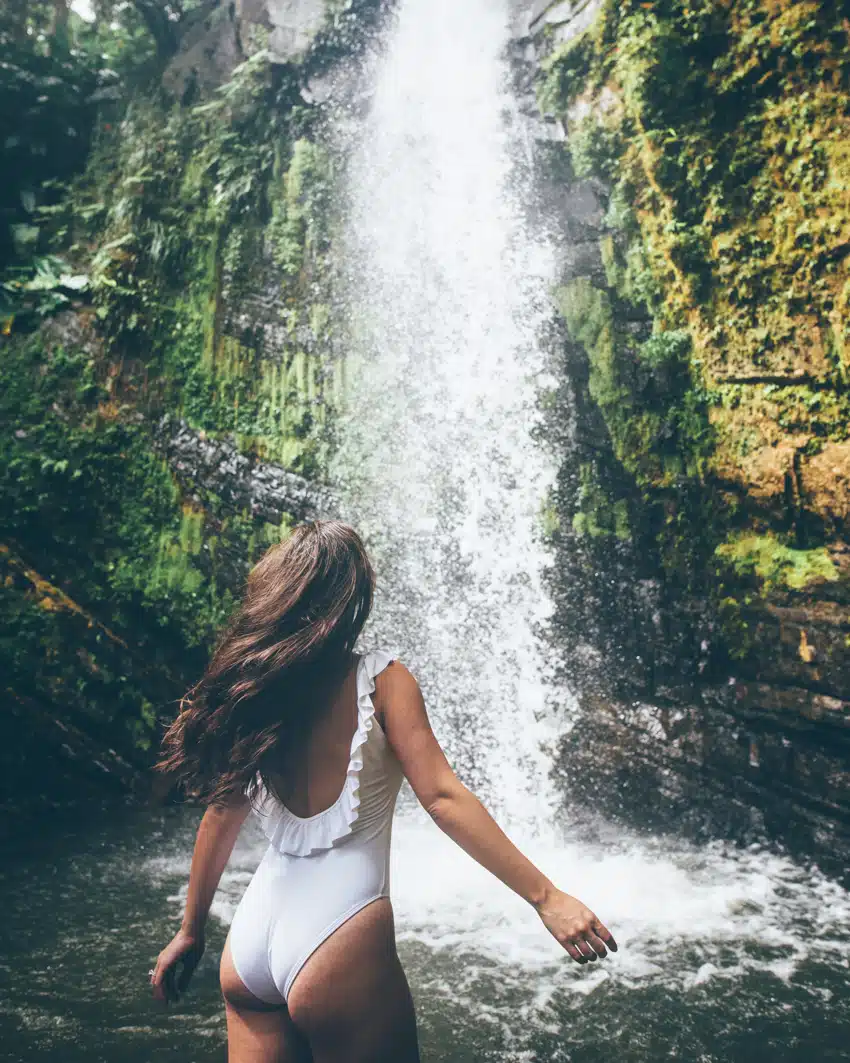
A visit to El Yunque National Forest is an absolute must when traveling to Puerto Rico!
Fortunately, it’s relatively easy to see the only tropical rainforest in the United States! It is easily accessible from the Puerto Rican capital, San Juan, and nearby beaches and smaller towns. What’s more, visiting El Yunque on your own is very possible!
The Luquillo Mountains and lush rainforest are calling for you to seek your adventures. Will you answer?
Safe travels!
Jasmine
PS. If you found this post helpful, please share it on Pinterest! You can use one of the images below for easy pinning!















12 Responses
Thank you so much for providing me with such detailed and insightful information. Your knowledge and expertise on the subject are truly impressive, and I feel fortunate to have access to your insights. Your generosity in sharing your time and expertise is greatly appreciated. More information for visit this website Can You Bring Solar Panels On A Plane? {2023}
Hello,
Since August, reservations are no longer required to access to El Yunque National Forest main recreational area.
Thank you for the update! I have updated the post to reflect that 🙂
This is extremely helpful. Thank you so much for your wonderful record keeping. I am just curious about the sequence of your stops. According to the map, if you start from the visitor center, you will pass La Coca Falls, Yokahu Tower, Juan Diego Falls, La Mina Falls, then Caimitillo picnic area with trailhead that leads to the Peak , and Mt. Britton Tower at the end of PR 191. But your writing implies otherwise. Could you kindly clarify?
I thoroughly enjoyed reading your insights on visiting El Yunque and the self-guided tour. My family (wife two daughters) and I are visiting in March 2024 and still a bit undecided about which route would be beneficial for us, guided vs. self-guided, however, your blog gave me more clarity and now I am leaning towards the self-guided route. Well done – Thank you.
I’m glad to hear it! I’d choose self-guided, too! I hope you have (or had) a wonderful time!
Hello,Jasmine.
I live in Richardson, Texas and will be taking my wife in April for 7 days and your article is exactly what I was looking for.
I’m so glad to hear it, thanks for letting me know! I hope you guys have a wonderful time!
I used this blog post for my self-guided tour through El Yunque with my husband and it went great! Very helpful and gave us all the info that we needed for a successful day in the rainforest. Thank you!
I’m so happy to hear that! Thanks for letting me know, Alex!!
can you recommend a small group tour not to strenuos, the trip is february. we have a car . maybe 6 to 8 people. what company is the most reliable. great details.
can you recommend a small group tour not to strenuos, the trip is february. we have a car . what company is the most reliable. great details.